What is a Fraction Bar?
We can express a fraction visually using a fraction model. One common model for doing this is the fraction bar. It is a bar model representation of a fraction.
A fraction is a number that describes a part of a whole. To better understand fractions, it helps to see what they look like.
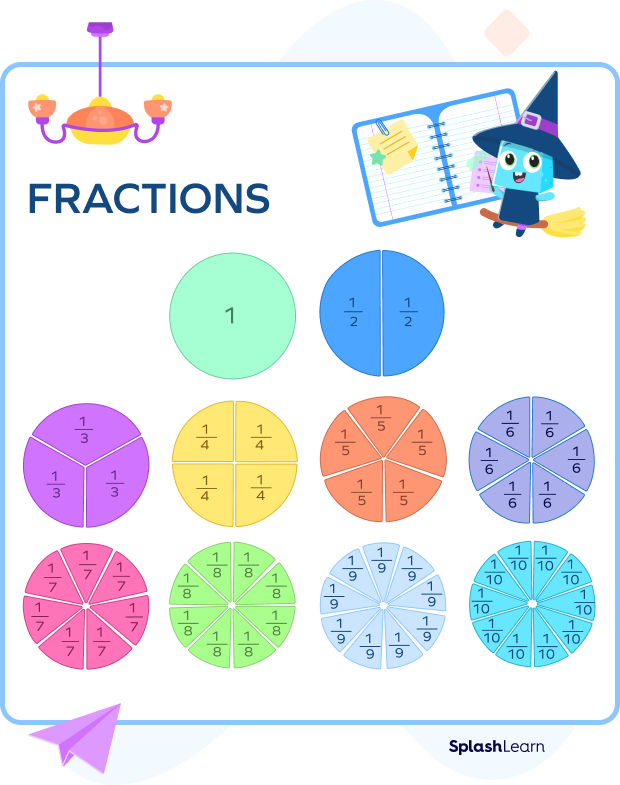
For example, $\frac{1}{8}$ represents 1 part out of 8 equal parts.
Seeing this as a visual representation helps us compare different fractions and understand how operations with fractions work.
Recommended Games
Fraction Bar Definition
In math, a fraction bar can be defined as a visual representation of fractions that helps in comparing fractions and carrying out operations with fractions.
Fraction bars or fraction strips are a part-to-whole representational model.
Each part of a fraction bar represents one unit out of a whole. This is why it is known as a part-to-whole representation.
This is most commonly represented as a bar split into equal units where the number of shaded units tells us the number of parts represented.
Consider an example of a fraction bar model. In the fraction bars below, the shaded portion of the first bar represents 2 out of 3 parts. The shaded portion of the second bar represents 8 out of 12 parts.
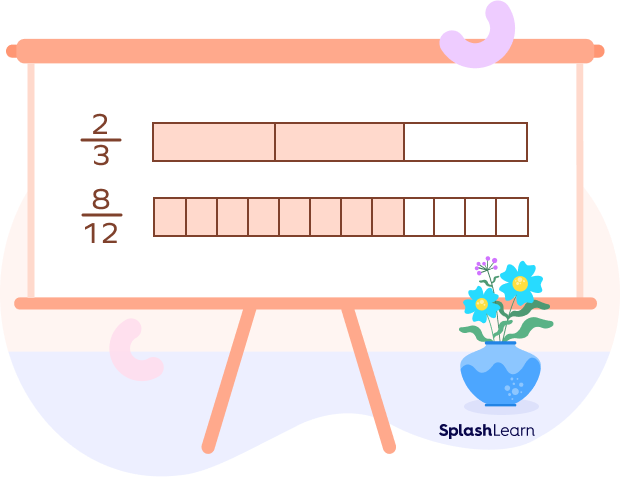
Here is the fraction bar chart for halves, thirds, fourths, fifths, sixths, sevenths, and eighths. They are also known as unit fractions since their numerator is 1.
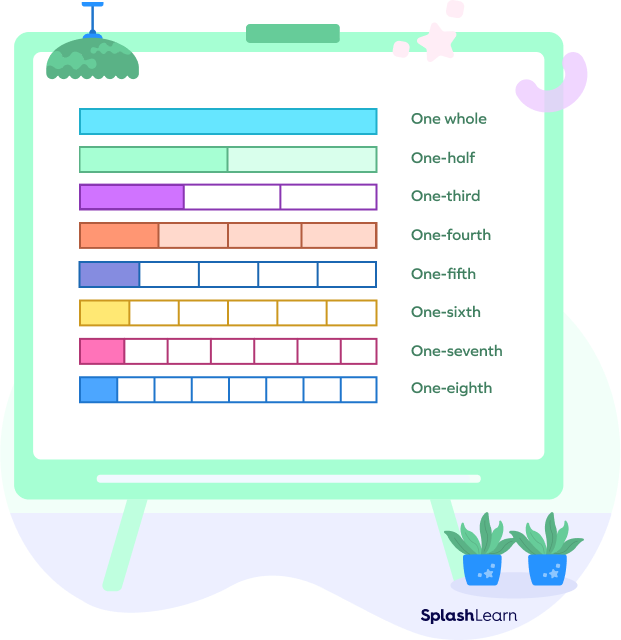
Recommended Worksheets
Comparing Fractions and Solving Problems with Fraction Bars
As we discussed earlier, fraction strips make comparing fractions and carrying out operations on fractions easy.
Comparing Fractions
Let’s take a look at an example.
The first green bar shows $\frac{1}{2}$ of the whole, while the yellow bar shows $\frac{1}{3}$ of the whole.

When we compare the first bar and the second bar, the shaded area in the yellow bar is less than the shaded area of the green bar, hence it is easy to see that $\frac{1}{3}$ is a smaller fraction than $\frac{1}{2}$. Thus, we can infer that $\frac{1}{2}$ is greater than $\frac{1}{3}$.
When we compare the third blue bar with the first green bar, we can see that $\frac{1}{4}$ is half of $\frac{1}{2}$, as the shaded portion is half the size of the first bar.
Fun Facts!
1. Fraction bars and strips are types of bar models.
2. The vinculum or bar that separates the numerator and denominator in a fraction is also referred to as the fraction bar.
Let’s Do It!
Play a game with your child. Cut 10 strips of chart paper. Give your child crayons and a ruler. Ask them to represent different fractions you say on the strips. You can use the same strips further and ask your child to compare two fractions or add or subtract them.
Solved Examples
1. Identify the smallest fraction from the given model.
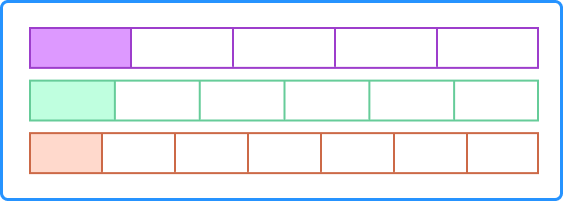
Solution: The first bar, which is blue in color, represents $\frac{1}{5}$; the second bar, which is yellow in color, represents $\frac{1}{6}$; the third bar, which is red in color, represents $\frac{1}{7}$. Since the red area is the least shaded, the fraction pertaining to the red area is the smallest. That is $\frac{1}{7}$.
2. Based on the bar model shown below, which is greater: $\frac{2}{3}$ or $\frac{8}{12}$?
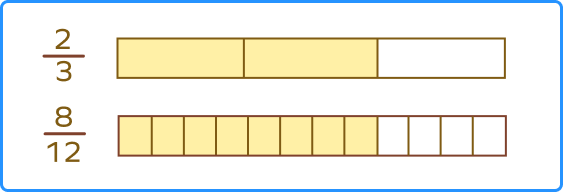
Solution: We can see that the shaded portions are equal, and neither is greater.
Therefore, $\frac{2}{3} = \frac{8}{12}$
3. Compare $\frac{1}{2}$, \frac{1}{4}$ and $\frac{1}{8}$ using the given fraction strips.
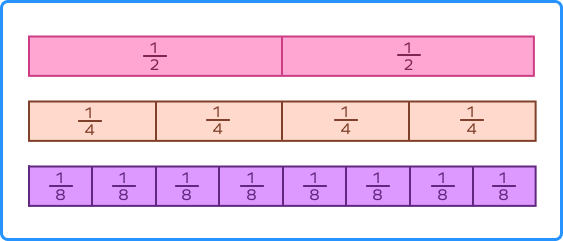
Solution: We can see that two $\frac{1}{4}$ parts are the same as one $\frac{1}{2}$ bar. Four $\frac{1}{8}$ parts make one $\frac{1}{2}$ bar.
Therefore, $\frac{1}{4} \times 2 = \frac{1}{2}$
So, $\frac{1}{4}$ is half of $\frac{1}{2}$.
Also, $\frac{1}{8} \times 4 = \frac{1}{2}$ and $\frac{1}{8} \times 2 = \frac{1}{4}$
So, $\frac{1}{8}$ is half of $\frac{1}{4}$.
Practice Problems
Fraction Bar
What is the fraction shown in the first bar?
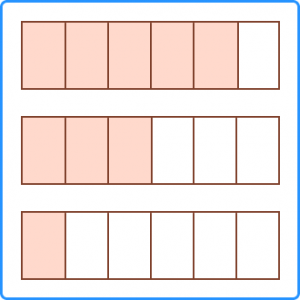
The first bar shows 6 equal units, of which 5 units are shaded. This represents the fraction $\frac{5}{6}$.
What is the fraction represented by the given fraction strips?
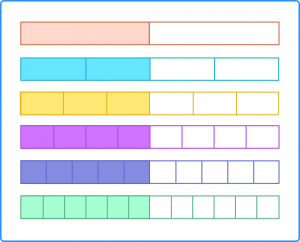
There are 6 fraction bars. Observe that the number of parts shaded in each bar are different but the shaded and unshaded region is the same. So, they all represent the same fraction, $\frac{1}{2}$.
$\frac{1}{2}=\frac{2}{4}=\frac{3}{6}=\frac{4}{8}=\frac{5}{10}=\frac{6}{12}$
What is the fraction shown below?
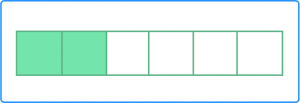
2 parts are shaded out of 6 equal parts, which represents $\frac{2}{6}$.
Identify the greater fraction from the given fraction model.
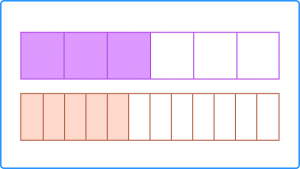
The first bar shows $\frac{3}{6}$. The second bar shows $\frac{5}{12}$.
Since the shaded area of the first bar is greater than the shaded area of the second bar, the first bar represents the greater fraction which is $\frac{3}{6}$.
Frequently Asked Questions
A fraction bar is a kind of bar model. A bar model is a pictorial representation of a math concept on a bar to make it easier to understand. A fraction bar is a specific kind of bar model that represents a fraction or a fraction problem.
What is the difference between a fraction bar and a number line?
A fraction bar is a bar that shows fractions as smaller parts of a whole bar. It shows the fractions through a part-to-whole representation. A number line is a visual representation of real numbers on a line with points marked.
What can a fraction bar be used for?
A fraction bar can be used to represent fractions as parts of a whole. It can be used to compare different fractions with each other. It can also be used to show fraction problems and operations with fractions, such as the addition and subtraction of fractions.




































